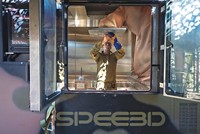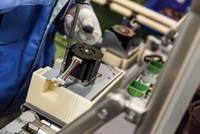Advertisement
Grab your lab coat. Let's get started
Welcome!
Welcome!
Create an account below to get 6 C&EN articles per month, receive newsletters and more - all free.
It seems this is your first time logging in online. Please enter the following information to continue.
As an ACS member you automatically get access to this site. All we need is few more details to create your reading experience.
Not you? Sign in with a different account.
Not you? Sign in with a different account.
ERROR 1
ERROR 1
ERROR 2
ERROR 2
ERROR 2
ERROR 2
ERROR 2
Password and Confirm password must match.
If you have an ACS member number, please enter it here so we can link this account to your membership. (optional)
ERROR 2
ACS values your privacy. By submitting your information, you are gaining access to C&EN and subscribing to our weekly newsletter. We use the information you provide to make your reading experience better, and we will never sell your data to third party members.
Polymers
Helping soldiers print with reclaimed plastic
Bottles and containers could become feedstocks for 3-D printing on remote military bases
by Bethany Halford
August 21, 2018

Supplying remote military bases with everything soldiers need can be a challenge, particularly when it comes to materials that aren’t a priority for a mission. Soldiers can sometimes wait weeks for simple items, such as a bracket that secures a radio to a vehicle. While military bases often have three-dimensional printers to make these parts, the commercially available plastic feedstock filaments aren’t always available. Soon though, service members may be able to sidestep the supply chain altogether and 3-D print parts using filaments made from discarded plastic items, such as water bottles and food containers.
Nicole Zander and colleagues at the U.S. Army Research Laboratory, working in collaboration with U.S. Marine Corps Capt. Anthony Molnar, have worked out the parameters to transform discarded polyethylene terephthalate (PET) and other plastics into feedstock filaments for 3-D printers. Zander reported on the work at the American Chemical Society national meeting in Boston on Tuesday during a presentation in the Division of Polymer Chemistry.
“A lot of soldiers tell me that they just want to print a clip for their backpack to make it fit better or something to hold a water bottle from a belt loop—a lot of little things like that, which will make them more comfortable,” Zander said.
To construct plastic parts, 3-D printers use 1.75-mm-diameter filaments of a given plastic, heating them and then depositing the melted plastic layer by layer in a desired pattern. “It’s essentially like a hot glue gun only fancier,” Zandershe explained.
It’s hard to make such feedstock filaments from PET, Zander says. The polymer can become brittle and is sensitive to moisture, readily undergoing chemical hydrolysis. Filament makers get around this problem by chemically modifying PET, but Zander wanted soldiers on remote bases to be able to simply reach into a recycling bin and get what they need.
She says the key was cleaning and drying the PET and then working out the best methods for shredding it, melting it, and then using a sophisticated extruder to make it into filament. “Once you get it into filament form, it actually prints pretty well,” Zander said.
The team designed a suite of equipment that can be used with a 3-D printer to process the recycled plastic. In one test of the setup, the researchers made a vehicle radio bracket using the plastic from 10 water bottles (Additive Manuf. 2018, DOI: 10.1016/j.addma.2018.03.007). This part proved to be just as durable as a bracket printed from commercially available filament.
Dayton Horvath, a principal at NewCap Partners and an independent consultant in 3-D printing, pointed out that there are a number of startup companies working to transform reclaimed plastic into filaments. He said that while Zander and colleagues’ work is valuable to materials scientists, a more rigorous study is needed to determine how varied conditions will affect filaments made from recycled plastic as well as the performance of finished parts. “When time is limited and environmental factors cannot fully be controlled, the process tolerance and efficiency must be understood, and then engineered to be robust enough to satisfy military specifications for such plastic parts,” he said.
Advertisement
Zander noted that this work isn’t focused on making critical structural parts, but rather on useful parts that can take a while to reach bases through the supply chain. “We need to determine which parts we can meet the specifications on, and build knowledge and understand limitations of this technology so we can know when and how it can be used,” she said. To that end, they plan to get feedback on printed components from soldiers working in the field.





Join the conversation
Contact the reporter
Submit a Letter to the Editor for publication
Engage with us on Twitter